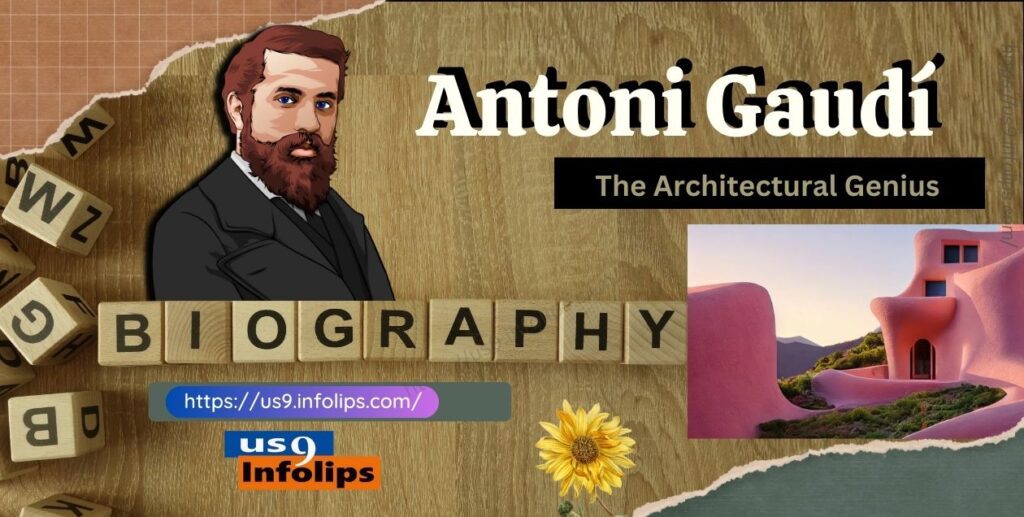Antoni Gaudí : The Architectural Genius and His Enduring Social Contributions
Antoni Gaudí: The Architectural Genius and His Enduring Social Contributions
Introduction
Antoni Gaudí, a name synonymous with architectural brilliance, revolutionized the world of design with his unique and imaginative creations. His works, characterized by their vibrant colors, organic shapes, and innovative techniques, continue to captivate people around the globe.
This article delves into the life of Antoni Gaudí, tracing his journey from his humble beginnings to becoming one of the most influential architects in history.
Table of Contents
1. Early Life and Birth
Humble Beginnings
Antoni Gaudí was born on June 25, 1852, in Reus, a small town in Catalonia, Spain. He was the youngest of five children in a family of coppersmiths. This artisanal background deeply influenced his future work, imbuing him with a profound appreciation for craftsmanship and materials.
Childhood and Family
Growing up, Gaudí was a sickly child, suffering from rheumatism, which kept him from playing with other children. This period of isolation fostered a deep connection with nature, as he spent hours observing the natural world, a theme that would later permeate his architectural designs.
2. Education and Formative Years
Early Education
Gaudí’s early education took place in his hometown, where he demonstrated a keen interest in geometry and drawing. His talent for sketching and his imaginative nature were evident from a young age.
Architectural Studies in Barcelona
In 1873, Gaudí moved to Barcelona to study architecture at the Escola Tècnica Superior d’Arquitectura. Despite being an average student, his unique perspective and innovative ideas caught the attention of his professors. He graduated in 1878, ready to leave his mark on the architectural world.
3. Initial Architectural Projects
First Professional Works
After graduation, Gaudí began working on small projects, including lamp posts and kiosk designs. His early works, though modest, displayed a distinctive style and attention to detail that set him apart from his contemporaries.
Collaboration with Eusebi Güell
Gaudí’s career took a significant turn when he met Eusebi Güell, a wealthy industrialist who became his lifelong patron. This partnership resulted in some of Gaudí’s most famous works, including the Güell Palace and the Güell Pavilions, showcasing his ability to blend functionality with artistic beauty.
4. Breakthrough with Park Güell
Design and Concept
One of Gaudí’s most celebrated projects is Park Güell, a public park system composed of gardens and architectural elements. Commissioned by Güell, the park was intended as a residential complex, but it eventually became a public park. Gaudí’s design incorporated intricate mosaics, organic shapes, and colorful tiles, creating a whimsical and enchanting environment.
Impact and Reception
Although initially a commercial failure, Park Güell has since become a symbol of Gaudí’s genius and a UNESCO World Heritage Site. Visitors from around the world marvel at its innovative design and playful ambiance.
5. La Sagrada Família
Vision and Inspiration
Arguably Gaudí’s most iconic work, La Sagrada Família is a basilica that epitomizes his architectural vision. Inspired by his deep religious faith, Gaudí envisioned the church as a spiritual and artistic masterpiece. He took over the project in 1883, dedicating the rest of his life to its construction.
Challenges and Innovations
Gaudí introduced groundbreaking techniques in the design and construction of La Sagrada Família, including hyperboloid structures and inclined columns. Despite numerous challenges, including financial constraints and the complexity of the design, he persevered, believing it was his divine mission.
6. Casa Batlló and Casa Milà
Unique Design Elements
Casa Batlló and Casa Milà, also known as La Pedrera, are two of Gaudí’s residential masterpieces in Barcelona. Casa Batlló, with its undulating facade and vibrant mosaics, resembles a dragon, while Casa Milà’s stone facade and wrought-iron balconies showcase Gaudí’s fascination with organic forms and natural light.
Cultural Significance
Both buildings have been recognized as UNESCO World Heritage Sites and are considered essential stops for anyone exploring Gaudí’s work. They exemplify his ability to transform ordinary buildings into extraordinary works of art.
7. Personal Life and Beliefs
Religious Devotion
Gaudí’s deep Catholic faith profoundly influenced his work. He saw his architecture as a form of worship, often integrating religious symbols and themes into his designs. His devoutness earned him the nickname “God’s Architect.”
Lifestyle and Personality
Known for his modesty and frugal lifestyle, Gaudí devoted himself entirely to his work. He never married and lived a simple life, channeling all his energy and resources into his architectural projects.
8. Later Years and Final Projects
Final Architectural Endeavors
In his later years, Gaudí focused almost exclusively on La Sagrada Família. He lived on the construction site, continually refining his designs and overseeing the work.
Health Decline
Gaudí’s health began to decline in the early 1920s. On June 7, 1926, he was struck by a tram while walking in Barcelona. Due to his unkempt appearance, he was initially mistaken for a beggar and received delayed medical attention. He died three days later, on June 10, 1926, and was buried in the crypt of La Sagrada Família.
9. Legacy and Death
Final Days
Gaudí’s death was a significant loss to the architectural world. His funeral was attended by a large crowd, reflecting the impact he had on the community and the respect he garnered throughout his life.
Posthumous Recognition
Gaudí’s legacy continued to grow after his death. La Sagrada Família, though unfinished, attracts millions of visitors annually and is on track for completion in the coming years. Gaudí’s innovative techniques and visionary designs have left an indelible mark on modern architecture.
Gaudí’s Architectural Style
Defining Features
Gaudí’s style is characterized by its use of vibrant colors, organic shapes, and intricate details. His incorporation of natural forms, such as plants and animals, into his designs was revolutionary, blending art with functionality.
Influences and Inspirations
His work was influenced by his love for nature, his religious efforts have been made to preserve and restore Gaudí’s works, ensuring they remain intact for future generations to admire. Organizations and foundations dedicated to his legacy work tirelessly to maintain the structural and aesthetic integrity of his masterpieces.
Achievements and Awards
Best Achievements:
- La Sagrada Família:
- Gaudí’s most renowned project, La Sagrada Família, stands as a monumental achievement in architectural design and engineering. Although unfinished, it is celebrated for its intricate facades, innovative structural elements, and profound religious symbolism.
- Gaudí’s most renowned project, La Sagrada Família, stands as a monumental achievement in architectural design and engineering. Although unfinished, it is celebrated for its intricate facades, innovative structural elements, and profound religious symbolism.
- Park Güell:
- Initially conceived as a residential project, Park Güell was transformed into a public park that showcases Gaudí’s ability to blend architecture with nature. It features whimsical designs, colorful mosaics, and unique architectural elements that draw millions of visitors each year.
- Initially conceived as a residential project, Park Güell was transformed into a public park that showcases Gaudí’s ability to blend architecture with nature. It features whimsical designs, colorful mosaics, and unique architectural elements that draw millions of visitors each year.
- Casa Batlló and Casa Milà (La Pedrera):
- These iconic residential buildings in Barcelona exemplify Gaudí’s mastery of organic forms and his innovative use of materials. Both buildings are UNESCO World Heritage Sites and are considered masterpieces of Modernisme (Catalan Art Nouveau).
- These iconic residential buildings in Barcelona exemplify Gaudí’s mastery of organic forms and his innovative use of materials. Both buildings are UNESCO World Heritage Sites and are considered masterpieces of Modernisme (Catalan Art Nouveau).
- Palau Güell:
- One of Gaudí’s early works for his patron Eusebi Güell, this mansion in Barcelona is noted for its elaborate ironwork, innovative use of space, and the integration of natural light. It is also a UNESCO World Heritage Site.
Awards:
- Grand Cross of the Order of Isabella the Catholic (1930):
- Posthumously awarded, this honor recognized Gaudí’s contributions to Spanish culture and architecture. The Order of Isabella the Catholic is a Spanish civil order granted in recognition of services that benefit the country.
- Posthumously awarded, this honor recognized Gaudí’s contributions to Spanish culture and architecture. The Order of Isabella the Catholic is a Spanish civil order granted in recognition of services that benefit the country.
- UNESCO World Heritage Sites:
- Several of Gaudí’s works have been designated as UNESCO World Heritage Sites, highlighting their cultural and architectural significance. These include:
- Park Güell
- Palau Güell
- Casa Milà (La Pedrera)
- Casa Vicens
- La Sagrada Família (Nativity Façade and Crypt)
- Casa Batlló
- Crypt of the Colònia Güell
- Several of Gaudí’s works have been designated as UNESCO World Heritage Sites, highlighting their cultural and architectural significance. These include:
- RIBA Royal Gold Medal (posthumously in 2015):
- The Royal Institute of British Architects (RIBA) awarded Gaudí the Royal Gold Medal for Architecture posthumously in recognition of his outstanding contributions to the field. This prestigious award is given to individuals or groups who have significantly influenced the advancement of architecture.
- The Royal Institute of British Architects (RIBA) awarded Gaudí the Royal Gold Medal for Architecture posthumously in recognition of his outstanding contributions to the field. This prestigious award is given to individuals or groups who have significantly influenced the advancement of architecture.
- Cultural Heritage of Humanity:
- Gaudí’s influence and legacy have been celebrated globally, with his works being integral to the cultural heritage of humanity. His innovative designs and pioneering techniques continue to inspire architects and artists worldwide.
Unknown facts about Antoni Gaudí:
- Vegetarian and Health Conscious:
- Gaudí was a vegetarian for much of his life, influenced by his dedication to a simple and healthy lifestyle. He believed that a natural diet would help him stay in better health.
- Gaudí was a vegetarian for much of his life, influenced by his dedication to a simple and healthy lifestyle. He believed that a natural diet would help him stay in better health.
- Artistic Craftsman:
- Before becoming an architect, Gaudí worked as a coppersmith, a skill he inherited from his father and grandfather. This early exposure to craftsmanship profoundly influenced his attention to detail in his architectural works.
- Before becoming an architect, Gaudí worked as a coppersmith, a skill he inherited from his father and grandfather. This early exposure to craftsmanship profoundly influenced his attention to detail in his architectural works.
- Inspired by Nature:
- Gaudí often took long walks in the countryside to observe nature, which inspired his designs. He believed that nature was the ultimate source of architectural forms and incorporated natural shapes and structures into his work.
- Gaudí often took long walks in the countryside to observe nature, which inspired his designs. He believed that nature was the ultimate source of architectural forms and incorporated natural shapes and structures into his work.
- Unconventional Use of Models:
- Instead of traditional blueprints, Gaudí frequently used three-dimensional models to plan his buildings. He would build these models to scale and modify them as his ideas evolved, ensuring that every detail was meticulously crafted.
- Instead of traditional blueprints, Gaudí frequently used three-dimensional models to plan his buildings. He would build these models to scale and modify them as his ideas evolved, ensuring that every detail was meticulously crafted.
- The Mosaic Technique:
- Gaudí popularized the use of “trencadís,” a type of mosaic created from broken ceramic tiles. This technique is prominent in many of his works, including Park Güell and Casa Batlló.
- Gaudí popularized the use of “trencadís,” a type of mosaic created from broken ceramic tiles. This technique is prominent in many of his works, including Park Güell and Casa Batlló.
- Devout Religious Practices:
- Gaudí was deeply religious and often attended daily mass. His faith played a significant role in his work, especially in La Sagrada Família, which he considered his spiritual mission.
- Gaudí was deeply religious and often attended daily mass. His faith played a significant role in his work, especially in La Sagrada Família, which he considered his spiritual mission.
- Rejection of Modern Conveniences:
- Gaudí avoided many modern conveniences, such as using elevators or automobiles. He preferred walking and kept a simple, ascetic lifestyle, even as his fame and wealth grew.
- Gaudí avoided many modern conveniences, such as using elevators or automobiles. He preferred walking and kept a simple, ascetic lifestyle, even as his fame and wealth grew.
- Personal Sacrifices for La Sagrada Família:
- Gaudí invested much of his own money into the construction of La Sagrada Família. In his later years, he lived in a small room on the construction site, dedicating himself entirely to the project.
- Gaudí invested much of his own money into the construction of La Sagrada Família. In his later years, he lived in a small room on the construction site, dedicating himself entirely to the project.
- Recognition During His Lifetime:
- While Gaudí is celebrated today, he was not universally appreciated during his lifetime. His unconventional style and eccentric personality made him a controversial figure among his contemporaries.
Controversies associated with Antoni Gaudí:
- Unconventional Designs:
- Gaudí’s architectural style was revolutionary and often controversial. His use of organic shapes, vibrant colors, and innovative materials clashed with the traditional and conservative architectural norms of his time, leading to mixed reactions from critics and the public.
- Gaudí’s architectural style was revolutionary and often controversial. His use of organic shapes, vibrant colors, and innovative materials clashed with the traditional and conservative architectural norms of his time, leading to mixed reactions from critics and the public.
- La Sagrada Família’s Funding:
- The financing of La Sagrada Família has been a subject of controversy since its inception. Initially funded by private donations, the project has faced financial difficulties, leading to debates over the allocation of public funds and the commercialization of the basilica to support its construction.
- The financing of La Sagrada Família has been a subject of controversy since its inception. Initially funded by private donations, the project has faced financial difficulties, leading to debates over the allocation of public funds and the commercialization of the basilica to support its construction.
- Religious Symbolism:
- Gaudí’s deep Catholic faith is embedded in his works, particularly La Sagrada Família, which is filled with religious symbolism. This strong religious presence has sparked debates about the role of religion in public architecture and the potential exclusion of non-Catholic perspectives.
- Gaudí’s deep Catholic faith is embedded in his works, particularly La Sagrada Família, which is filled with religious symbolism. This strong religious presence has sparked debates about the role of religion in public architecture and the potential exclusion of non-Catholic perspectives.
- Modernisme Movement:
- As a leading figure of the Modernisme movement, Gaudí’s work was often at odds with the traditional architectural establishment in Spain. His bold departure from classical styles stirred controversy among more conservative architects and critics who viewed his designs as overly eccentric and impractical.
- As a leading figure of the Modernisme movement, Gaudí’s work was often at odds with the traditional architectural establishment in Spain. His bold departure from classical styles stirred controversy among more conservative architects and critics who viewed his designs as overly eccentric and impractical.
- Urban Planning of Park Güell:
- Originally intended as a residential development, Park Güell failed commercially due to its impractical location and high costs. This failure led to criticism of Gaudí’s planning and vision, questioning his practicality as an architect.
- Originally intended as a residential development, Park Güell failed commercially due to its impractical location and high costs. This failure led to criticism of Gaudí’s planning and vision, questioning his practicality as an architect.
- Casa Milà (La Pedrera) Criticism:
- Casa Milà, one of Gaudí’s most famous works, faced significant criticism upon completion. Its unconventional wavy facade and lack of straight lines were derided by some as an eyesore, earning it the nickname “La Pedrera” (the stone quarry).
- Casa Milà, one of Gaudí’s most famous works, faced significant criticism upon completion. Its unconventional wavy facade and lack of straight lines were derided by some as an eyesore, earning it the nickname “La Pedrera” (the stone quarry).
- Health and Safety Concerns:
- Gaudí’s obsessive attention to detail and unorthodox methods sometimes led to challenging working conditions on his construction sites. Reports of unsafe practices and the high demands placed on workers sparked controversies about labor conditions and safety standards.
- Gaudí’s obsessive attention to detail and unorthodox methods sometimes led to challenging working conditions on his construction sites. Reports of unsafe practices and the high demands placed on workers sparked controversies about labor conditions and safety standards.
- Delay in Completion of La Sagrada Família:
- The prolonged construction of La Sagrada Família, which began in 1882 and is still ongoing, has been a point of contention. Critics argue that the project has deviated from Gaudí’s original vision and question whether the ongoing work truly reflects his intentions.
- The prolonged construction of La Sagrada Família, which began in 1882 and is still ongoing, has been a point of contention. Critics argue that the project has deviated from Gaudí’s original vision and question whether the ongoing work truly reflects his intentions.
- Personal Eccentricities:
- Gaudí’s personal lifestyle and eccentricities, including his reclusive nature and austere living conditions, often drew public and media attention. His unconventional behavior and appearance sometimes overshadowed his professional achievements, leading to a polarized public perception.
Antoni Gaudí’s best social contributions:
- La Sagrada Família:
- Gaudí’s masterpiece, La Sagrada Família, is not only an architectural marvel but also a profound symbol of faith and community. It has become a pilgrimage site and a source of inspiration for millions of visitors from around the world.
- Gaudí’s masterpiece, La Sagrada Família, is not only an architectural marvel but also a profound symbol of faith and community. It has become a pilgrimage site and a source of inspiration for millions of visitors from around the world.
- Park Güell:
- Originally intended as a residential project, Park Güell was transformed into a public park, providing a unique and enchanting space for the community to enjoy. It offers a blend of nature and art, serving as a serene retreat within Barcelona.
- Originally intended as a residential project, Park Güell was transformed into a public park, providing a unique and enchanting space for the community to enjoy. It offers a blend of nature and art, serving as a serene retreat within Barcelona.
- Promotion of Catalan Culture:
- Through his works, Gaudí promoted Catalan identity and culture. His designs often incorporated Catalan symbols and motifs, fostering a sense of pride and cultural heritage among the people of Catalonia.
- Through his works, Gaudí promoted Catalan identity and culture. His designs often incorporated Catalan symbols and motifs, fostering a sense of pride and cultural heritage among the people of Catalonia.
- Innovative Use of Materials:
- Gaudí’s pioneering use of recycled materials, such as broken ceramic tiles for mosaics (trencadís), was an early example of sustainable design. This approach not only showcased creativity but also promoted environmental consciousness.
- Gaudí’s pioneering use of recycled materials, such as broken ceramic tiles for mosaics (trencadís), was an early example of sustainable design. This approach not only showcased creativity but also promoted environmental consciousness.
- Public Accessibility:
- Many of Gaudí’s projects, including Casa Batlló and Casa Milà, have been opened to the public as museums. This accessibility allows people from all walks of life to experience and appreciate his architectural genius.
- Many of Gaudí’s projects, including Casa Batlló and Casa Milà, have been opened to the public as museums. This accessibility allows people from all walks of life to experience and appreciate his architectural genius.
- Employment Opportunities:
- The construction of Gaudí’s projects provided numerous jobs for artisans, craftsmen, and laborers. His attention to detail and demand for high-quality craftsmanship helped sustain traditional crafts and provided employment during challenging economic times.
- The construction of Gaudí’s projects provided numerous jobs for artisans, craftsmen, and laborers. His attention to detail and demand for high-quality craftsmanship helped sustain traditional crafts and provided employment during challenging economic times.
- Urban Beautification:
- Gaudí’s architectural works contributed significantly to the beautification of Barcelona. His buildings and parks enhanced the city’s aesthetic appeal, making it a more attractive destination for tourists and boosting the local economy.
- Gaudí’s architectural works contributed significantly to the beautification of Barcelona. His buildings and parks enhanced the city’s aesthetic appeal, making it a more attractive destination for tourists and boosting the local economy.
- Educational Influence:
- Gaudí’s innovative techniques and visionary designs have been studied extensively in architectural schools worldwide. His work continues to inspire and educate future generations of architects, contributing to the evolution of architectural education.
- Gaudí’s innovative techniques and visionary designs have been studied extensively in architectural schools worldwide. His work continues to inspire and educate future generations of architects, contributing to the evolution of architectural education.
- Legacy of Creativity and Innovation:
- Gaudí’s legacy extends beyond his physical creations. His approach to design, which combined functionality with artistic expression, has inspired countless individuals to pursue creativity and innovation in their own fields.
- Gaudí’s legacy extends beyond his physical creations. His approach to design, which combined functionality with artistic expression, has inspired countless individuals to pursue creativity and innovation in their own fields.
Conclusion
Antoni Gaudí’s life was a testament to the power of imagination and dedication. From his early years in Catalonia to his monumental contributions to modern architecture, Gaudí’s journey is one of unparalleled creativity and spiritual devotion.
His works, celebrated for their unique blend of art and function, continue to inspire and captivate millions worldwide. Gaudí’s architectural genius transformed the skyline of Barcelona and left an indelible mark on the world, ensuring that his legacy will endure for centuries to come.
FAQs
Q.1: What is Antoni Gaudí best known for?
Ans: Antoni Gaudí is best known for his unique architectural style characterized by vibrant colors, organic shapes, and intricate details. His most famous works include La Sagrada Família, Park Güell, Casa Batlló, and Casa Milà.
Q.2: How did Antoni Gaudí’s religious beliefs influence his work?
Ans: Gaudí’s deep Catholic faith profoundly influenced his work. He saw his architecture as a form of worship and often incorporated religious symbols and themes into his designs. His devotion earned him the nickname “God’s Architect.”
Q.3: Which of Gaudí’s works are UNESCO World Heritage Sites?
Ans: Several of Gaudí’s works have been designated as UNESCO World Heritage Sites, including Park Güell, Palau Güell, Casa Milà (La Pedrera), Casa Vicens, La Sagrada Família, Casa Batlló, and the Crypt of the Colònia Güell.
Q.4: How did Gaudí’s architectural style evolve over time?
Ans: Gaudí’s architectural style evolved from early influences of Gothic and Oriental architecture to a more mature style characterized by organic forms and naturalistic elements. His later works, particularly La Sagrada Família, reflect his innovative use of geometry and his integration of structural and decorative elements.
Q.5: What makes La Sagrada Família unique?
Ans: La Sagrada Família is unique for its intricate design, innovative use of geometry, and the incorporation of religious symbolism throughout the structure. It is an ongoing project, with construction continuing long after Gaudí’s death, adhering to his visionary plans while incorporating modern techniques.
Q.6: How long did Gaudí work on La Sagrada Família?
Ans: Gaudí worked on La Sagrada Família for over 40 years, from 1883 until his death in 1926. It remains unfinished and continues to be built according to his original vision.
Q.7: What materials did Gaudí commonly use in his buildings?
Ans: Gaudí frequently used natural materials such as stone, ceramics, and iron. He also pioneered the use of colorful mosaics, often created from broken ceramic tiles, known as “trencadís.”
Q.8: Why is Park Güell considered a failure as a residential project?
Ans: Park Güell was initially intended as a residential development but failed commercially due to the lack of interest from buyers. Despite this, it was later transformed into a public park and became one of Gaudí’s most beloved creations.
Q.9: What was Gaudí’s philosophy towards architecture?
Ans: Gaudí believed that architecture should be an extension of nature. He often drew inspiration from natural forms and incorporated organic shapes into his designs, striving to create harmony between his buildings and their surroundings.
Follow us for more captivating articles and stay connected to explore the world. Let’s embrace the power of communication and understanding.
Disclaimer: The views in this article are given with the help of information available on the net. Readers are encouraged to conduct their own research before making any decisions. The publisher disclaim any liability for any loss or damage caused directly or indirectly.

Related topics:
1. Perfect World Travel Guide
2. 9 Most Popular EV Cars in the USA
3. 9 Best Things About Apple TV 4K – Third Generation
4. Think before You Renew Amazon Prime
5. Jimmy Carter: A Great Legacy
6. Memorial Day: Honoring the Sacrifice, Celebrating Freedom
School Site :
For English grammar and lot more : Smart School Infolips
Marathi Poems: Marathi Rang












